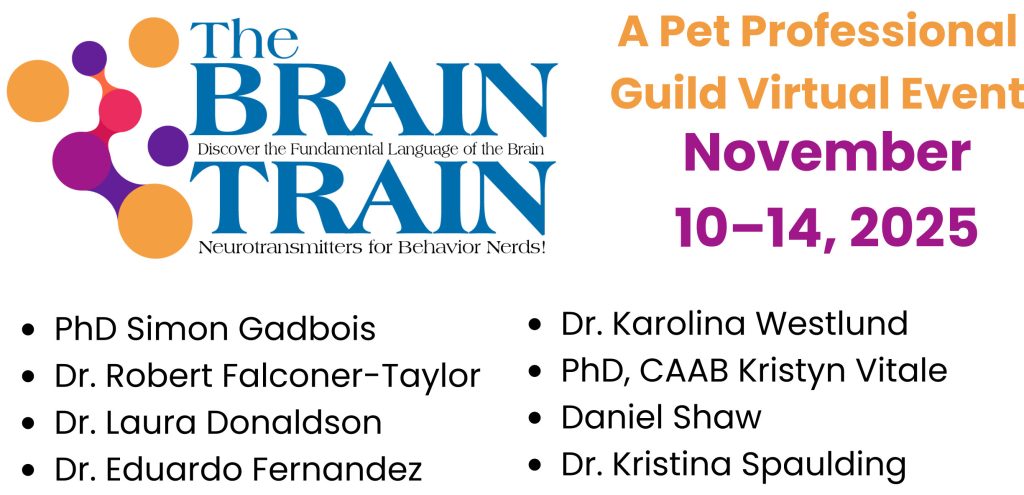Training
Shaping without a Clicker
Most trainers agree that if there is one thing that the tool called a clicker is useful for in particular, it is for shaping behavior. Shaping consists of marking and reinforcing successive approximations towards a goal behavior. When shaping, the trainer can find herself needing to mark very small or quick movements indeed, sometimes just a weight shift or a breath. When that is the case, the behavior is usually long over by the time one can get food or a toy to the animal. A clicker or other marker can form a “bridge” between the… Continued
Learning by Observation
This is a really exciting time to be a canine professional. Dogs have come to the forefront in research, giving us new information about how they learn as well as their cognitive abilities. This new data allows trainers and behaviorists to influence canine learning and explain behavior using innovative and scientifically valid methods. A simple example is dogs learning through observation. When I began training dogs 15 years ago, we did not believe dogs learned by watching us or other dogs. I distinctly remember being scoffed at by my mentor… Continued
Hello, May I Have Your Attention?
We’ve all been there, sitting in the audience waiting for the guest speaker to come on stage. Or it could be at a wedding or even a classroom. The crowd is talking, laughing in a collective rumble, when suddenly someone notices that the speaker is on stage, waiting patiently for everyone to take notice. Sometimes you can hear the “shushhhhhhhh”, but within a matter of seconds the audience is in rapt attention….the silence is deafening. Compare that to the unfortunate speaker who tries to talk above the noise: “Excuse me,… Continued

Misconceptions of Counterconditioning Leash Reactive Dogs
Misconception #1 – Feeding a dog when they are barking or fearful reinforces the fear. Absolutely not true. You can only cause more fear by implementing more fear or pain. Fear trumps food, so if the dog is taking the food, they are not that fearful. The food is not the focus of the on leash event; the impending, approaching or sudden stimulus is the focus. This is not like a food bowl that gets kicked repeatedly or a dog that is attacked by other dogs over food, and the… Continued
Not All “Choices” Are Equal
Shout-outs to Companion Animal Psychology for the post, The Right to Walk Away” which covers the effects of offering that particular choice in animal experiments, and encourages us to apply the concept to our animals’ lives. Also to Yvette Van Veen for her piece, “A” Sucks “B” Stinks What Kind of Choice is That? , which definitely has some “rant” commonalities with this post of mine. We positive reinforcement-based trainers often point out that our dogs have the choice not to participate in a training session. I think giving the animal “the right to… Continued
Distinguishing Ourselves as Force-Free Professionals
Some time ago I engaged in an online conversation with a dozen or more force-free trainers and the subject of professional certification came up. Most of the trainers had CPDT-KA credentials and some were considering letting them lapse because they saw little value in it. Others were new to the business and planned on testing for certification. One very experienced trainer rejected the need for certification and declared dog owners did not care about credentials. In my experience only two or three owners ever asked basic questions to determine whether… Continued
Non-Aggressive Behaviors as a Precursor to Outright Aggression
Certain non-aggressive behaviors are often overlooked, yet can be a precursor to outright aggression if the dog is pushed to the point of no return. Colleen Pelar investigates the issues of escape and avoidance in the child-dog relationship. Originally published in BARKS from the Guild as Less Is More, May 2015, page 27. Is Avoidance Okay? Many people divide dog behavior into two categories: aggressive and non-aggressive. That is logical enough, but there are plenty of non-aggressive behaviors that indicate that a dog could still do with some help. If… Continued
An Open Letter to Canine Research Scientists
PPG Member Linda Michaels MA PCT-A calls on canine research scientists to lead the way on the ethical treatment of companion animals and take a stand against shock collars. It would require a long list to delineate the benefits of companion animal canine research conferences and live streams. Admirably, these conference bring canine researchers into the mainstream of the canine applied practices fields, i.e., dog training. Many pet parents and trainers take careful note of scientific positions and plan to incorporate the lessons-learned into their practice. The researchers benefit in… Continued
The Nose Knows
A well-known test devised in 1970 by psychologist Gordon Gallup Jr. is used to determine whether an animal recognizes himself in a mirror. This “mirror test” is widely regarded as the “gold standard” for determining whether an animal is self-aware, that is, recognizes himself as a distinct individual and has a concept of self. This test may very well do that — sometimes, for some animals. Chimpanzees and some other primates pass easily; elephants and dolphins also pass. Most dogs do not, and, for many scientists, this is held up… Continued
Why Self-Control is Better than “Discipline”
The Oxford Dictionary defines ‘discipline’ as: ‘The practice of training people to obey rules or a code of behavior, using punishment to correct disobedience.’ The word ‘discipline’ not only carries with it the baggage of “force” and “dominance,” but also a hint of worthiness. And yet, ‘that dog needs discipline’ is a phrase we may still hear on a regular basis. ‘That dog needs to be taught some self-discipline’ is a lot more appropriate because it drops the implications of punishment. The definition of ‘self-discipline’ is: ‘The ability to control one’s feelings and overcome one’s weaknesses.’ Discipline… Continued
Tired Dogs, Good Dogs, Dogs Being Dogs
“How much exercise does my dog need?” This question sounds straightforward enough, but peel it apart and you’ll find it has several layers. Inquiring dog owners crave reassurance that they’re doing right by their dogs, meeting their needs. Also embedded in the query may be “I love my dog but…how can I get her to leave me alone when I’m trying to relax?” And sometimes, let’s be honest because we’ve all been there, it’s a plea for a manageable minimum investment of time: “Life is crazy busy, and I don’t want… Continued
Six Myths about Positive Reinforcement-Based Training
Positive reinforcement-based training is subject to a lot of misunderstanding and misrepresentation. Many people genuinely don’t understand how it works, and others seem to deliberately misrepresent it. Some of these misunderstandings and misrepresentations are very “sticky.” Misunderstandings, straw men, myths–call them what you will, but they are out there and they are potent. Here are six that are quite common. There are many more out there. For example, I didn’t even hit on “dogs trained with R+ are obese” or “R+ training only works for tricks and easy dogs” or “R+… Continued
Sheepherding, from the Lamb’s Perspective (Part Two)
Following my first interview with the lambs I was intrigued and felt even more determined to understand the experience of sheepherding from their perspective, so the next time Renee brought Chris and Rue to practice I went into covert “sheep mode” and joined the flock. Oh, I did not don a silly lamb outfit. It was much too hot for that. I maintained a low profile and did my best to blend among the lambs wearing a white t-shirt to match their fleece, and khaki shorts to match the sunburned… Continued
Laying the Foundations
This article was written by Barb Levenson and first published in BARKS from the Guild, July 2014, pp. 24-26. I was attending an agility trial recently and was sitting by the crating area massaging my dog. A couple sitting behind me had two Labradors, the older one their agility competition dog. This dog was allowed to be loose on his mat, unleashed and uncrated. I turned around to see him with his back to his owner and his nose in the rear of a nearby dog. The man called the… Continued

BARKS Podcasts – Teach Me Force-Free
Teach Me Force-Free If you’re gonna teach me, teach me force-free People can be good and kind and that’s a great philosophy I can flourish, I can learn if you’ll just help me Show me, guide me, be my friend and train me happy I can be the best dog I can be if you believe in me And if you’re gonna teach me, teach me force-free If you’re gonna teach me, teach me force-free. © Maria Daines/Paul Killington Written and recorded for The Pet Professional Guild
Can you FIX my dog?
When clients contact me, they often ask, “Can you fix my dog?” It has become something I smile about now, but nonetheless a pet peeve. There’s nothing wrong with the word itself, but let’s take a look at it applied to a living, breathing animal. Used as a verb to FIX something by definition is to fasten (something) securely in a particular place or position and that is not something to do with dogs, although I am sure your imagination can give a quick picture of what that might look… Continued
Very Clear on the Concept
Jana started learning concepts and putting things into categories way back when she was a puppy, before Chaser was even born. Chaser is the most famous “categorizing” dog; she has learned the names of well over 1,000 items and can group them into the right categories: toys, balls, Frisbees, etc. In addition, she has demonstrated an understanding of grammar, correctly taking one item to another, for example. She also can watch, remember, and imitate complex strings of behaviors. Chaser’s story is told in Chaser: Unlocking the Genius of the Dog Who… Continued

How Force-Free Training Helped Save My Dog’s Life!
Written by Louise Stapleton-Frappell Yesterday I shared a post on Facebook about Pamela Johnson’s “Rattlesnake Avoidance Training Using Force-Free Methods,” a Pet Professional Guild webinar. (You can register and watch the webinar here). Last night we had a thunderstorm and my Staffy bull terrier, Jambo, was frightened so I stayed up with him. The storm finally passed and at 2am I took him and Tessa, our German shepherd, outside for a bathroom break. There was a toad at the bottom of the steps but unfortunately, I didn’t see it until Jambo made contact. As a… Continued
PPG World Service Radio Show Launches with Trial Podcast
PPG World Service is the official international e-Radio web-casting arm of The Pet Professional Guild. The mission of PPG World Service is “Global News & Views on Force-Free Pet Care” and will serve as an advocacy forum for force-free dog training and pet care issues. The PPG World Service broadcast will initially be aired once per month with the goal of increasing this frequency as the audience builds. Together we are hoping to create a fun, educational and informative show. So come along and join us, bring your questions, expertise… Continued
Positive Reinforcement Training Tips
They don’t call them “man’s best friend” for nothing! Domestic dogs have for thousands of years lived with humans in various capacities, from aiding in hunting to protecting livestock. In order to perform these functions, dogs learned to communicate with people and perform as their owners wished. Dogs are highly sensitive and responsive animals. They can tell when their owners are happy, sad, or nervous, and they may express these emotions themselves. Because dogs do have feelings, and intelligence that may be compared to that of a toddler (some breeds… Continued
Sheepherding, from the Lamb’s Perspective (Part One)
Sheep herding is a wonderful way for a handler and a dog to work together as a team in a time-honored tradition going back hundreds of years. Herding is the process of moving livestock by using a dog, such as a border collie. It requires close coordination between the handler and dog, moving the sheep in an orderly and predictable manner to the desired location. I once read “sheep herding is a dialogue of instinct occurring between dog and sheep” but I suspect that was written by someone who was… Continued
“Be NICE!”
If I’m a dog, and I’m on a leash, and another dog invades my space, I’m gonna growl. That’s just how I feel. Back the heck off, pal! I can’t get away from you, on account of I’m on a leash! That means you need to get away from me. Please and thank you. Plain and simple. So how come my person chides me and snaps, “Be NICE!” What?! I am nice. I just don’t want this guy all up in my business. How about my person could be nice and get… Continued
Socializing a Formerly Feral Dog
When I started this blog, I assumed that I would write a lot about Clara’s training. Clara burst into my life as a 10 week old feral puppy [see note at end about feral dogs], and her socialization window was in the process of closing by the time she came to me. I slipped in that window before it shut and was fully accepted and trusted. But she growled at all other humans, even at that young age. In general, she related to them as a wild animal would, with huge wariness of… Continued
Nothing Changes if Nothing Changes
This article was written by Barb Levenson BS and first published in BARKS from the Guild (2014, April) pp. 26-27. Are you shouting cues or asking your dog for behaviors with a soft tone of voice? In a beginner rally class one night, I had an opportunity to show the difference between using a soft tone of voice to some of my students. One of the dogs, an adolescent lab, was somewhat anxious during class. I noticed that the owner, who was a very receptive student, was ‘barking’ cues to… Continued
« Previous 1 … 21 22 23 24 25 … 28 Next »

